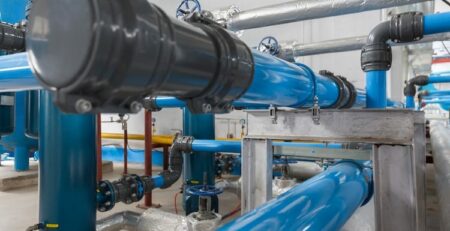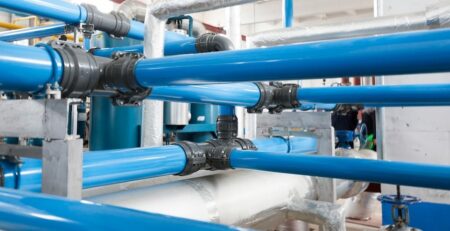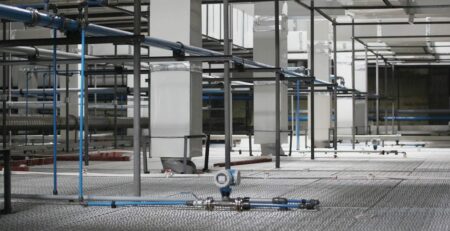Nissan Uses Compressed Air to Achieve Energy Savings
Nissan North America operates on a massive scale. The company’s powertrain assembly plant in Decherd, Tennessee, alone encompasses 1.1 million square feet, and manufactures engines for 14 different vehicles. The facility also handles crankshaft forgings, cylinder block castings, and other machining applications.
Over the course of one year, the powertrain plant churns out approximately 1.4 million engines, an equal number of crankshaft forgings, and 456,000 cylinder block castings.
If you extrapolate that scale of operation to Nissan’s ten other locations across North America, you can get a grasp of just how big the company’s manufacturing presence really is. And, when you start talking about energy management, any one project can become a major undertaking involving a large number of people. Those projects also have a tremendous impact — both financially and environmentally.
Nissan’s formal energy management program is called the Nissan Green Program, and it has helped Nissan earn recognition as an ENERGY STAR® Partner of the Year from the U.S. Environmental Protection Agency (EPA) every year since 2010.
Compressed air projects play a huge part in Nissan’s energy management program — especially when you consider that compressed air accounts for more than one fifth of the powertrain plant’s total energy spend. We had the opportunity to learn about the Nissan Green Program from one of the company’s key professionals in energy management, Mike Clemmer, Director/Plant Manager — Paint & Plastics at Nissan North America. Specifically, Clemmer discussed Nissan’s energy management strategy as it pertains to compressed air, detailing specific optimization projects that led to substantial energy savings.
Managing Compressed Air at Nissan
Compressed air is an integral part of Nissan’s operations, and is used for a wide range of applications. Compressed air piping networks run throughout the company’s manufacturing facilities, and the energy management team places a lot of emphasis on finding and repairing air leaks.

Compressed air is a vital part of the manufacturing operations at Nissan’s vehicle assembly plant in Canton, Mississippi.

Nissan uses compressed air in a wide variety of applications, including spray finishing.
“Compressed air is essential to any manufacturing process, particularly in the automotive industry, and it accounts for about 23 percent of total energy costs at our powertrain facility,” Clemmer explained. “With that in mind, we have two full-time workers in each of our manufacturing facilities — vehicle assembly plants in Smyrna, Tennessee, and Canton, Mississippi, and the powertrain plant in Decherd, Tennessee — dedicated to identifying and repairing air leaks. By regularly checking the meters, conducting leak checks and repairs, and performing audits, the energy team aims to achieve a compressed air leak rate of less than 10 percent of compressor output.”

Nissan employs full-time personnel dedicated to identifying and repairing air leaks at each manufacturing facility.

By vigilantly repairing compressed air leaks, Nissan aims to achieve a leak rate of less than 10 percent of compressor output.
Optimizing Air Compressor Controls to Match Demand
Controlling air compressor performance is another focus area for the energy team at Nissan. In one of the projects that Clemmer described, engineers at Nissan centralized their compressed air monitoring system, giving them better insight into how the plant uses its compressed air supply.
“We have simplified the monitoring process by tying the air compressors in several of our manufacturing facilities into a central computer that monitors the system pressure and handles the loading/unloading of the machines,” Clemmer explained. “This has reduced the run-time of our machines to support our manufacturing operations, and it reduced motor starts, which led to improved stability of pressure in our plants.”
In addition, Nissan’s engineers are leveraging inlet guide vanes to better match plant demand with their centrifugal compressors.
“We are also optimizing the control sequence to further reduce unloaded compressed air though the bypass valve,” Clemmer said. “Our manufacturing sites operate multiple centrifugal compressors, and they are equipped with inlet guide vanes. By operating multiple inlet guide vanes in sequence, we are able to throttle our compressed air supply to meet plant demand. We’ve managed to almost entirely eliminate bypassed air with this system.”
Curbing Compressed Air Use
Compressed air is an essential resource for the manufacturing facilities of Nissan North America — to the extent that it is almost ubiquitous. The vehicle assembly plant in Canton, Mississippi, is capable of producing 450,000 vehicles in one year, and it employs more than 6,000 people. At that scale, there is a lot of potential for compressed air waste.

Nissan’s Vehicle Assembly Plant in Canton, Mississippi, produces 10 different vehicle models and spans 1,034 acres.

An inside look at Nissan North America’s assembly plant in Canton, Mississippi
However, two of those employees are exclusively dedicated to diagnosing and repairing compressed air leaks throughout the facility’s 4.2 million square feet. That is the kind of concerted effort needed to maintain energy savings through compressed air management.
Nissan North America’s compressed air optimization projects are just a few of the many energy management initiatives that help Nissan to operate more sustainably. But, when their cumulative impact is measured across the massive scale of operations, even curbing the slightest amount of compressed air makes a major impact.









